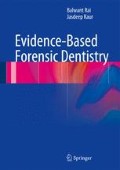Abstract
Teeth are among the hardest structures of the human body as well as resistant to adverse condition, so they are used as an identification tool in forensic odontology investigations. They are also a valuable source of DNA, as other parts of the body are destroyed or degraded in mass disasters. This chapter focuses on the role of DNA technology in forensic odontology.
Access this chapter
Tax calculation will be finalised at checkout
Purchases are for personal use only
References
Anzai EK, Hirata MH, Hirata RDC, Nunes FD, Melani RFA, Oliveira RN (2005) DNA extraction from human saliva deposited on skin and its use in forensic identification procedures. Braz Oral Res 19(3):216–222
Butler JM (2005) Forensic DNA typing: biology, technology and genetics of STR markers. Academic, San Diego
Combined DNA Index System (CODIS) (2011) Federal Bureau of Investigations. http://www.justice.gov/oig/reports/FBI/a0126/final.pdf. Accessed 20 July 2011
Gaytmenn R, Sweet D (2003) Quantification of forensic DNA from various regions of human teeth. J Forensic Sci 48:622–625
Komuro T, Nakamura M, Tsutsumi H, Mukoyama R (1998) Gender determination from dental pulp by using capillary gel electrophoresis of amelogenin locus. J Forensic Odontostomatol 16:23–26
Malaver PC, Yunis JJ (2003) Different dental tissues as source of DNA for human identification in forensic cases. Forensic Sci 44(3):306–309
Olaisen B, Stenersen M, Mevåg B (1997) Identification by DNA analysis of the victims of the August 1996 Spitsbergen civil aircraft disaster. Nat Genet 15:402–405
Pretty IA (2007) Forensic dentistry: 1. Identification of human remains. Dent Update 34:621–622, 624–626, 629–630
Rai B, Narula S, Madan M, Dhattarwal S (2004) Evidence of tooth in sex determination. Int J Med Legal Update 4(4):119–126
Schwartz TR, Schwartz EA, Mieszerski L, McNally L, Kobilinsky L (1991) Characterization of deoxyribonucleic acid (DNA) obtained from teeth subjected to various environmental conditions. J Forensic Sci 36:979–990
Shiroma CY, Fielding CG, Lewis JA Jr, Gleisner MR, Dunn KN (2004) A minimally destructive technique for sampling dentin powder for mitochondrial DNA testing. J Forensic Sci 49:791e5
Silva LAF, Passos NS (2002) DNA forense: Coleta de amostras biológicas em locais de crime para estudo do DNA. Ed UFAL, Maceió (in Portuguese)
Silva RH, Sales-Peres A, Oliveira RN, Oliveira FT, Sales-Peres SH (2007) Use of DNA technology in forensic dentistry. J Appl Oral Sci 15(3):156–161
Smith BC, Fisher DL, Weedn VW, Warnock GR, Holland MM (1993) A systematic approach to the sampling of dental DNA. J Forensic Sci 38(5):1194–1209
Sweet D (2001) Why a dentist for identification? Dent Clin N Am 45(2):237–251
Sweet D, DiZinno JA (1996) Personal identification through dental evidence—tooth fragments to DNA. J Calif Dent Assoc 24:35–42
Sweet DJ, Sweet CH (1995) DNA analysis of dental pulp to link incinerated remains of homicide victim to crime scene. J Forensic Sci 40:310–314
Sweet DJ, Lorente JA, Lorente M, Valenzuela A, Villanueva E (1997) An improved method to recover saliva from human skin: the double swab technique. J Forensic Sci 42:320–322
Tsuchimochi T, Iwasa M, Maeno Y, Koyama H, Inoue H, Isobe I et al (2002) Chelating resin-based extraction of DNA from dental pulp and sex determination from incinerated teeth with Y-chromosomal alphoid repeat and short tandem repeats. Am J Forensic Med Pathol 23(3):268–271
Vogel F, Motulsky AG, Motta PA (2000) Genética Humana Problemas e Abordagens. Guanabara Koogan, Rio de Janeiro (in Portuguese)
Walker MR, Rapley R (1999) Guia de Rotas na Tecnologia do Gene. Atheneu, São Paulo (in Portuguese)
Walker AH, Najarian D, White DL, Jaffe JM, Kanetsky PA, Rebbeck TR (1999) Collection of genomic DNA by buccal swabs for polymerase chain reaction based biomarker assays. Environ Health Perspect 107:517–522
Author information
Authors and Affiliations
Rights and permissions
Copyright information
© 2013 Springer-Verlag Berlin Heidelberg
About this chapter
Cite this chapter
Rai, B., Kaur, J. (2013). DNA Technology and Forensic Odontology. In: Evidence-Based Forensic Dentistry. Springer, Berlin, Heidelberg. https://doi.org/10.1007/978-3-642-28994-1_17
Download citation
DOI: https://doi.org/10.1007/978-3-642-28994-1_17
Published:
Publisher Name: Springer, Berlin, Heidelberg
Print ISBN: 978-3-642-28993-4
Online ISBN: 978-3-642-28994-1
eBook Packages: MedicineMedicine (R0)

